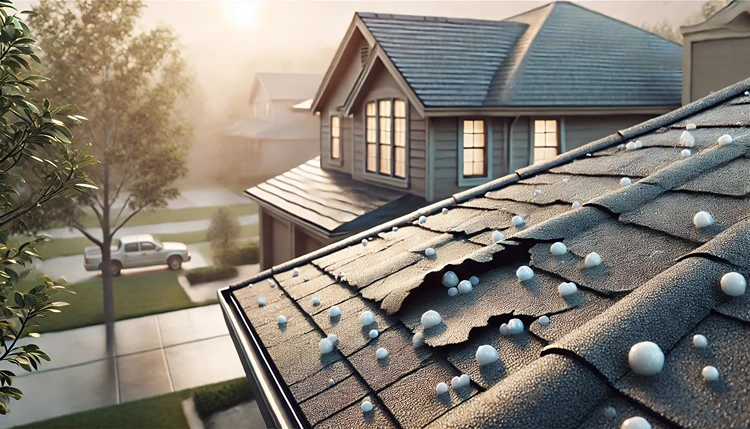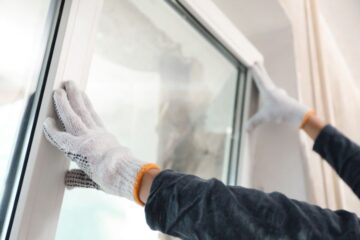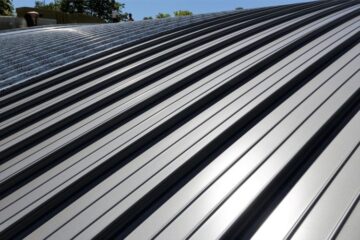Identifying Hail Damage on Asphalt Roofs: Key Indicators

Hail storms can wreak havoc on asphalt roofs, often leaving behind subtle signs of damage that might not be immediately visible. Identifying hail damage on asphalt roofs is crucial for preventing long-term issues like leaks or structural damage. In this guide, we’ll walk through the key indicators of hail damage on asphalt roofs and how to assess it before small problems turn into costly repairs.
What Does Hail Damage Look Like on Asphalt Roofs?
After a hail storm, your roof may not have obvious damage, but that doesn’t mean everything is fine. Hail can cause different types of wear depending on the size of the hailstones and the intensity of the storm. In most cases, damage shows up as bruising, cracking, or loss of granules on your asphalt shingles.
How Can You Spot Visible Signs of Hail Damage?
The most straightforward way to identify hail damage is by inspecting your roof for the following signs:
- Bruising: Hailstones can leave dark spots or bruises on the surface of the shingles. Gently running your hand over the shingle may reveal soft spots.
- Granule loss: Hail impact often dislodges the protective granules on asphalt shingles, exposing the underlying material to the elements.
- Cracking: Larger hailstones may cause the shingles to crack, especially in older roofs where the shingles are already brittle.
- Dents in metal components: Check for dents on metal parts of your roof, such as gutters, flashing, or vents. These dents can be a clear sign of hail impact.
Why Is Granule Loss Important?
Granule loss on your asphalt shingles is a key indicator of hail damage, but why does it matter? Granules provide a critical layer of protection against UV rays and weathering. When they’re stripped away, the asphalt becomes vulnerable to deterioration.
Helpful Hint:
If you notice granules collecting in your gutters after a hail storm, it’s a sign that your shingles may have been damaged. Act quickly to prevent further wear.
What Are the Risks of Ignoring Hail Damage?
Overlooking hail damage on your roof can lead to serious problems. Without proper inspection and repairs, small issues like granule loss or bruising can snowball into larger problems such as leaks, mold growth, or even structural damage.
Why Can Ignoring Hail Damage Lead to Bigger Problems?
- Leaks: Damaged shingles allow water to seep through the roof, which can lead to leaks in your home.
- Mold and mildew: Moisture trapped inside your roofing materials can encourage the growth of mold and mildew, causing health risks and further damage.
- Roof deterioration: Continued exposure to the elements without the protective layer of granules will cause the shingles to degrade faster, shortening the lifespan of your roof.
How to Inspect Your Asphalt Roof for Hail Damage
If you suspect your roof has been hit by hail, a proper inspection is essential. You can either conduct an initial visual inspection yourself or hire a professional roofer for a more detailed assessment.
Steps for Conducting a Visual Inspection
Here’s a simple guide to inspect your roof for signs of hail damage:
- Check the ground first: Look for any pieces of shingles or granules around your property, particularly in gutters or downspouts.
- Look for bruising or soft spots: Gently press on any dark spots or areas of concern. If they feel soft or spongy, this may indicate bruising from hail impact.
- Inspect flashing and vents: Check metal components like vents or flashing for dents or other visible damage.
- Check skylights and windows: If you have skylights or nearby windows, check for cracks or damage caused by hailstones.
Helpful Hint:
If your roof is steep or difficult to access, it’s safer to contact a professional roofing contractor to conduct the inspection. Avoid climbing on your roof without proper safety equipment.
What Should You Do If You Spot Hail Damage?
If you’ve identified hail damage, the next step is determining the severity and whether repairs are needed. In some cases, a simple repair may suffice, but in others, you might need a full roof replacement.
How to Decide Between Repairing or Replacing Your Roof
The decision to repair or replace your roof depends on several factors:
- Age of the roof: If your roof is nearing the end of its lifespan (typically around 20-30 years for asphalt shingles), replacement may be more cost-effective.
- Extent of the damage: Minor damage, such as a few cracked shingles, can often be repaired. Widespread granule loss or structural damage may require replacement.
- Insurance coverage: Contact your insurance company to see if your policy covers hail damage. A professional inspection and documentation can help with the claims process.
How Can You Tell If Hail Damage Is Severe?
It’s not always easy to determine how severe hail damage is, especially if the signs are subtle. However, some key indicators can help you figure out if the damage to your asphalt roof is significant enough to require immediate attention.
What Are the Signs of Severe Hail Damage?
While minor hail damage may not seem urgent, severe damage can lead to long-term problems if left unaddressed. Here are signs that the damage may be more serious:
- Multiple bruised shingles: If you notice numerous soft spots or bruises, the protective granules have likely been compromised, leaving large portions of your roof exposed to the elements.
- Cracks extending across shingles: Cracks that stretch across the surface of multiple shingles can indicate significant hail impact. This type of damage reduces the roof’s ability to keep water out.
- Water spots inside your home: Leaks or water spots on your ceilings or walls can mean hail damage has allowed water to penetrate through the roof.
- Damaged underlayment: If hailstones were large enough to damage the roof’s underlayment (the layer beneath the shingles), this poses a risk for extensive water damage and could require a full roof replacement.
Should You Call a Professional Roofer?
While a visual inspection can give you some clues about hail damage, calling a professional roofer for a detailed assessment is a smart move—especially if you’re dealing with a severe hailstorm. Roofers have the tools and expertise to evaluate the full extent of the damage, including areas that aren’t visible from the ground.
When Is It Time to Call a Professional?
Here are some situations where hiring a roofer makes sense:
- Multiple signs of damage: If you see granule loss, bruising, or cracks in multiple areas of your roof, a professional can assess whether the damage is widespread enough to require repairs.
- Hard-to-reach areas: Professional roofers can access steep or high roofs safely, ensuring every inch of your roof is checked for damage.
- Post-storm assessment: After a significant hailstorm, a professional assessment can help you determine if you need to file an insurance claim and avoid future problems.
Stats:
According to the National Roofing Contractors Association (NRCA), about 40% of all roof damage in the U.S. is caused by hailstorms, making it one of the most common reasons for roof repairs and replacements.
How Does Hail Size Affect Roof Damage?
The size of the hailstones plays a major role in the level of damage your roof may sustain. Understanding the relationship between hail size and roof damage can help you assess the severity of a storm and predict whether you’ll need repairs.
What Are the Typical Sizes of Hail and Their Effects?
Here’s a quick breakdown of typical hail sizes and their potential impact on asphalt roofs:
- Pea-sized hail (¼ inch): This small size is unlikely to cause significant damage but can still lead to minor wear, especially on older roofs.
- Marble-sized hail (½ to ¾ inch): Moderate damage can occur with this size, including bruising and granule loss.
- Golf ball-sized hail (1½ inches): Hail this size can cause more serious damage, including cracked shingles and significant granule loss.
- Baseball-sized hail (2½ inches or larger): Large hailstones can puncture shingles, damage the underlayment, and even create leaks in your roof.
The larger the hailstone, the greater the potential for severe damage. Roofs that are already aged or weakened are especially vulnerable to larger hail.
Can Hail Damage Impact Your Home Insurance?
Yes, hail damage can affect your home insurance in a variety of ways, from filing a claim to adjusting your coverage. Most standard homeowners’ insurance policies cover hail damage, but the specifics can vary depending on your policy and the extent of the damage.
How Does Insurance Handle Hail Damage?
Here’s what you should know about handling hail damage with your insurance:
- File a claim promptly: After a hailstorm, contact your insurance company right away to report the damage. The sooner you file, the faster the claims process will begin.
- Get a professional inspection: A roofer can provide a detailed report to your insurance company, helping you document the damage and making it easier to process the claim.
- Coverage limitations: Some insurance policies have deductibles specifically for hail damage. Be sure to review your policy to understand what’s covered and whether you’ll need to pay out-of-pocket for certain repairs.
Helpful Hint:
Before you experience a hailstorm, review your home insurance policy to ensure it includes adequate coverage for roof repairs or replacements due to hail damage.
What Are the Next Steps After Identifying Hail Damage?
Once you’ve identified hail damage on your roof, taking swift action is critical. Whether you choose to repair or replace the roof, here are the next steps to protect your home:
Steps to Take After Confirming Hail Damage
- Document the damage: Take photos of the damage and make notes about any leaks or other issues. This documentation is helpful for both contractors and insurance claims.
- Contact your insurance company: Report the damage to your insurer as soon as possible to begin the claims process.
- Hire a professional roofer: Whether or not you need to file an insurance claim, a professional roofer can assess the damage and make necessary repairs.
- Consider preventative measures: If hail damage has been a recurring issue in your area, consider upgrading to more impact-resistant roofing materials to prevent future problems.
Stats:
In a 2021 survey by the Insurance Information Institute, 1 in 20 homeowners filed an insurance claim for roof damage caused by wind or hail.
Hail Size and Roof Damage Impact
| Hail Size | Potential Roof Damage |
|---|---|
| Pea-sized (¼ inch) | Minimal damage, minor granule loss, surface wear. |
| Marble-sized (½ to ¾ inch) | Moderate damage, bruising, potential granule loss. |
| Golf ball-sized (1½ inches) | Cracking of shingles, significant granule loss, potential water damage risk. |
| Baseball-sized (2½ inches or larger) | Severe damage, broken shingles, punctures in roofing, possible structural damage. |
FAQs
Wrapping Up
Identifying hail damage on asphalt roofs is essential for preventing long-term problems like leaks and structural damage. By inspecting for signs such as bruising, granule loss, and cracking, homeowners can address issues early and avoid more costly repairs. If the damage is extensive, consulting with a professional roofer for a detailed assessment and possible repairs or replacements is the best course of action. Whether you need a simple repair or a full roof replacement, taking swift action after a hailstorm ensures your roof continues to protect your home effectively. Don’t let small damages linger—take care of your roof now to avoid future problems.


